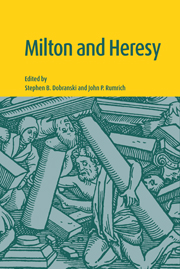Book contents
- Frontmatter
- Contents
- List of contributors
- Acknowledgments
- Abbreviations
- Introduction: Heretical Milton
- PART I HERETICAL THEOLOGY
- 1 Milton on heresy
- 2 Milton's antiprelatical tracts and the marginality of doctrine
- 3 How radical was the young Milton?
- PART II HERESY AND CONSEQUENCES
- PART III HERESY AND COMMUNITY
- PART IV READERS OF HERESY
- Index
3 - How radical was the young Milton?
Published online by Cambridge University Press: 10 October 2009
- Frontmatter
- Contents
- List of contributors
- Acknowledgments
- Abbreviations
- Introduction: Heretical Milton
- PART I HERETICAL THEOLOGY
- 1 Milton on heresy
- 2 Milton's antiprelatical tracts and the marginality of doctrine
- 3 How radical was the young Milton?
- PART II HERESY AND CONSEQUENCES
- PART III HERESY AND COMMUNITY
- PART IV READERS OF HERESY
- Index
Summary
Alongside George Sensabaugh's classic portrait of “That Grand Whig Milton” and Christopher Hill's leftist line-drawing of Milton the sometime associate of third culture radicals, a new sketch is taking form: Milton the confused elitist, divided against himself and inconsistent in his political ideas and allegiances. The young Milton especially has been represented as inconsistent and even something of a Cavalier, given that at times he used genres, imagery, publication modes, and stances associated with the court, the Laudian church, the Cavalier poets, and even with Roman Catholicism. But that image misrepresents Milton as badly as the engraving by William Marshall affixed to his 1645 Poems.
The new conception owes something to revisionist history, which reads the events of 1640–60 as a crisis touched off by political bungling and accident rather than as a revolution prompted by ideological conflict. It owes something also to postmodernist attention to ambiguities and inconsistencies in Milton's texts, and New Historicist emphasis on his inevitable containment within his own culture. But the moment seems to have come for revising the revisionists, for again recognizing that the trial and execution of an anointed king was an awesome revolutionary act with ideological causes and consequences. Some historians are now reaching beyond Whiggish and Marxist categories to reconsider the place of religion, apocalyptic history, and republican political theory in an emergent revolutionary ideology. And Miltonists like Michael Wilding, Cedric Brown, David Norbrook, and Sharon Achinstein have for some time been reclaiming and re-evaluating the reformist, republican, and radical elements in Milton's thought and his efforts to shape a revolutionary populace.
- Type
- Chapter
- Information
- Milton and Heresy , pp. 49 - 72Publisher: Cambridge University PressPrint publication year: 1998
- 2
- Cited by

